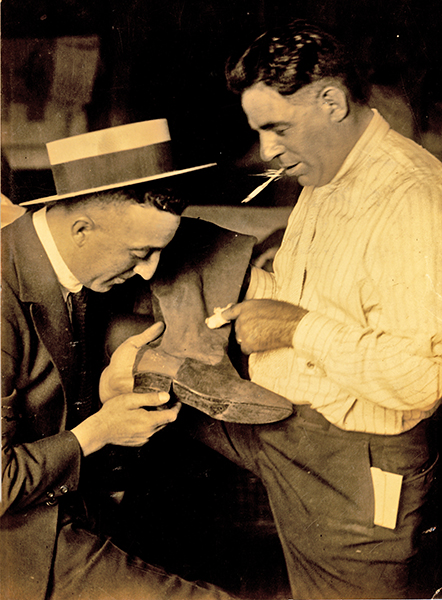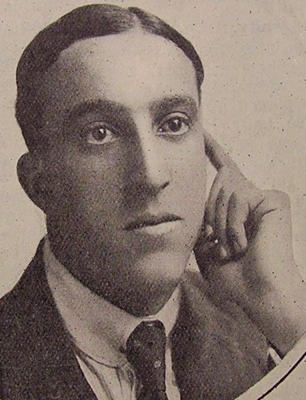On 8 July 1916 comedians Nat Phillips and Roy Rene stepped on to the stage of Sydney's Princess Theatre, presenting for the very first time their alter-egos Stiffy and Mo. By the time they ended their partnership 12 years later the pair had firmly established itself as one of the country's greatest-ever comedy duos.
Guest blogger Dr Clay Djubal looks back at Stiffy and Mo one hundred years after that debut and highlights the Fryer Library's unique relationship with writer, composer, producer and director and troupe leader Nat Phillips.

Nat Phillips Collection UQFL9, Fryer Library
Before Stiffy and Mo
Phillip Nathaniel Phillips (1883-1932) was already a veteran of Australian and international vaudeville by 1916, having spent nine years touring the USA, Great Britain and Europe, first with Tommy Armstrong and then with his wife Daisy Merritt. After returning to Australia in 1912 he worked for Fullers' Theatres as a performer, producer and theatre manager, and undertook a seven months tour of the East with Merritt. He also began developing an urban larrikin character called Stiffy the Rabbitoh, which he featured in comic sketches. While in Brisbane in late June 1916, Phillips was asked by the Fullers to take over a musical comedy company formerly run by Albert and Maude Bletsoe. One of the members of that troupe was Roy Rene.
Born Harry van der Sluys (1891-1954), Roy Rene was known in his teens as "Boy Roy the singing soprano" and during the early 1910s worked for various variety firms and managers as a blackface comedian before scoring his first long-term contract in 1913 with Sydney-based entrepreneur Harry Clay. The following year he began working a Hebrew comic turn, complete with the stereotypical hirsute-style make-up. In 1915 Rene was assigned a juvenile comedian role with Bletsoe's Tabloid Musical Comedy Company by Fullers' Theatres. This engagement ended in Rockhampton in late June 1916 when the Bletsoes suddenly retired. He was subsequently invited to join Nat Phillips new troupe. The two comedians met for the first time in Brisbane prior to taking the train to Sydney.
 Nat Phillips Collection UQFL9, Fryer Library |  Theatre Magazine April (1915), 35 |
Nat Phillips’ Tabloid Musical Comedy Co (featuring Stiffy and Mo): The Debut
Given only eight days to prepare for the Sydney season, Phillips engaged some leading veterans from the Fullers stable to supplement the remaining Bletsoe performers. Drawing on some of his Stiffy sketches, filled out with musical numbers and spots for improvised ‘biz,’ he put the actors through an intense series of rehearsals. Impressed with Rene’s comic timing and the rapport they had developed, Phillips quickly elevated the young comedian to Stiffy’s off-sider. According to Rene the biggest problem he faced was finding a name for his character. The original script for What Oh Tonight (held in the Nat Phillips Collection) indicates that Phillips envisaged a mate called Sol, but Rene didn't feel a connection with the name. In Mo's Memoirs (1945), he recalls that as opening came upon them stage manager, Bill Sadler came to the rescue with an off-hand remark, "Why don't you call yourselves Stiffy and Mo." And so a legend was born.
The What Oh Tonight manuscript also indicates that Phillips conceived the Stiffy and Sol/Mo partnership in the traditional comic/straightman format, but that evaporated when they discovered they could do both. In this respect Stiffy and Mo were unique. The pair also found their niche as urban rather than bush larrikins, articulating some of the national identity tropes being generated and assumed by Australians both at home and on active war service. The other Nat Phillips Collection manuscripts clearly demonstrate, for example, egalitarian ideals of mateship, anti-authoritarian attitudes and self-deprecation.

Nat Phillips Collection UQFL9, Fryer Library
Nat Phillips' Stiffy and Mo Revue Company: 1916-1928
Nat Phillips and Roy Rene's partnership lasted 12 years, albeit with an eighteen-month break (1925-1927). Their seasons in each of the capital cities invariably ran for months, and in some instances six months or more. They also played New Zealand twice, with the first tour (1923-1924) lasting almost 18 months. Although the two comedians have long commanded the most attention, newspapers and industry journals from the time indicate that the ensemble performers played a significant part in Stiffy and Mo’s success. Two of the best-known performers were Mike Connors and Queenie Paul. The troupe’s musical ensemble was also at the forefront of disseminating jazz to Australian’s during the late 1910s and the1920s.
In addition to their one-act musical comedies (aka revusicals), Stiffy and Mo regularly featured in Fullers' pantomimes, the first being The Bunyip (1916). They published Stiffy and Mo's Book of Fun in 1923, and were identified as the originators of a number of popular songs (written either by Phillips or other local songwriters). Some of their songs and comic business was also recorded.

Nat Phillips collection UQFL9, Fryer Library
Fryer Library's Nat Phillips Collection
The ten boxes of Fryer Library's Nat Phillips Collection include four complete Stiffy and Mo scripts (and one almost complete). There are also hundreds of sketches, scenas, jokes, photographs, songs (both published and unpublished), and all sorts of miscellanea. A “Finding Aid” for the collection became available in 2005 after some three years of painstaking collation. It also became the cornerstone of my 2005 PhD dissertation, “What Oh Tonight: The Methodology Factor and Pre-1930s Australian Variety Theatre.”
Interestingly, the collection came to the Fryer Library through an accident of fate, or more precisely, as the result of a wife scorned. It was discovered in the mid-1970s by a University of Queensland lecturer and his wife as they browsed through a Brisbane antique shop. Although documentation relating to the collection’s acquisition has long been missing, information supplied by the Phillips family provides some insight into how it survived. The woman scorned was the wife of Nat Phillips' brother Jack (who is also represented in the collection). After their marriage ended she kept the boxes and eventually settled in Brisbane. Jack’s death soon afterwards saw the family lose touch with her, and it wasn’t until many years later that they realised that the manuscripts had gone missing. The boxes were likely stored at the Cremorne Theatre at some stage as some materials unrelated to Nat Phillips are also held within the collection. It is believed that Mrs Phillips’ death led to the boxes being sold or given to the Brisbane antique shop… and the rest, as they say, is history.
Nat Phillips Collection UQFL9, Fryer Library
For further details see:
- Nat Phillips Papers (Collection UQFL9). Fryer Library, The University of Queensland.
- The Nat Phillips Collection, Fryer Folios 1:1, September 2006, 10-12
- “Australian Variety Theatre.” eSpace. The University of Queensland.
See also: AustLit: The Australian Literature Resource:
- Stiffy and Mo: Icons of Australian Comedy began 100 Years Ago (anniversary blog)
- Stiffy and Mo
- Nat Phillips’ Stiffy and Mo Revue Company
- Nat Phillips
- Roy Rene
- Stiffy
- What Oh Tonight
- Nat Phillips Whirligigs
See also the Australian Variety Theatre Archive: